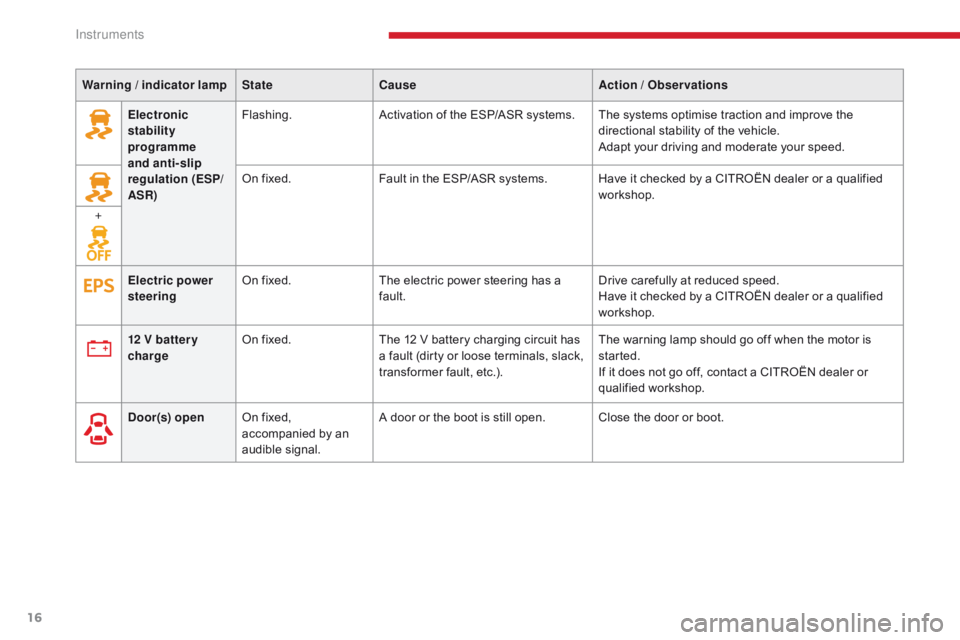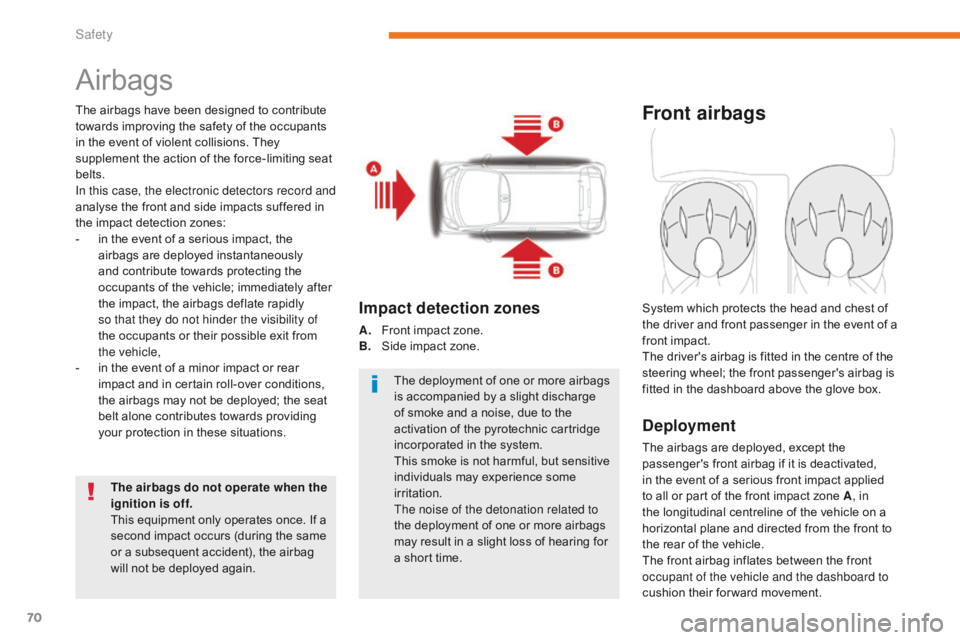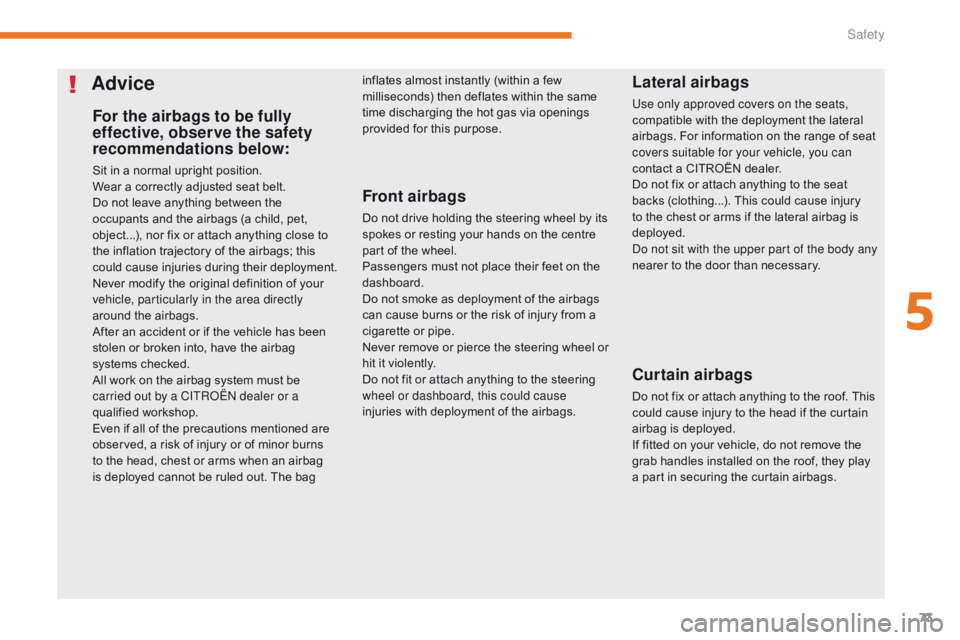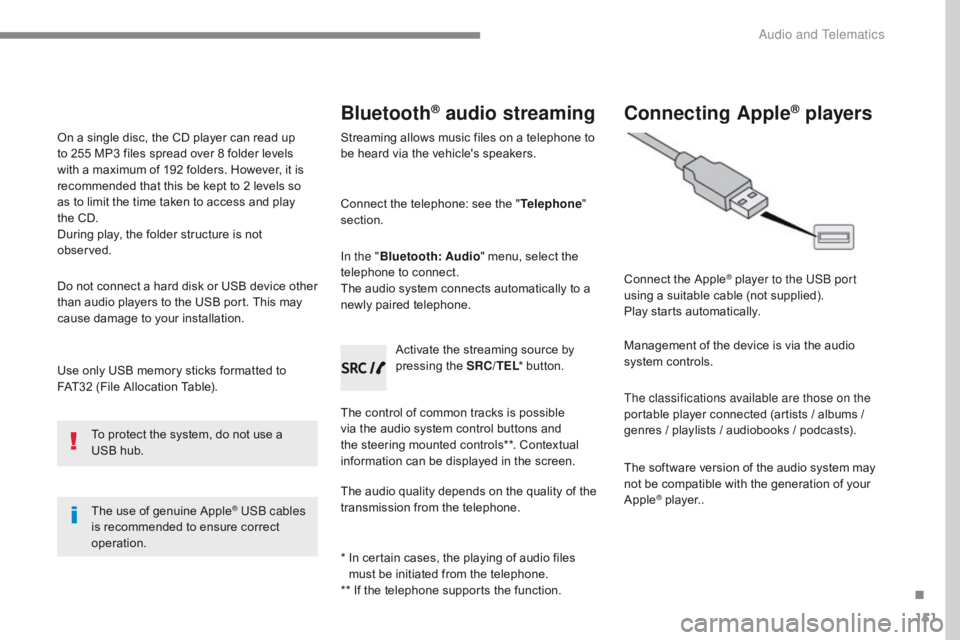steering CITROEN C-ZERO DAG 2017 Handbook (in English)
[x] Cancel search | Manufacturer: CITROEN, Model Year: 2017, Model line: C-ZERO DAG, Model: CITROEN C-ZERO DAG 2017Pages: 174, PDF Size: 4.56 MB
Page 18 of 174

16
C-Zero_en_Chap01_instruments-de-bord_ed01-2016
Electronic
stability
programme
and anti-slip
regulation (ESP/
ASR)Flashing.
Activation of the ESP/ASR systems. The systems optimise traction and improve the
directional stability of the vehicle.
Adapt your driving and moderate your speed.
On fixed. Fault in the ESP/ASR systems. Have it checked by a CITROËN dealer or a qualified
workshop.
+
Door(s) open On fixed,
accompanied by an
audible signal. A door or the boot is still open. Close the door or boot.
12 V
battery
charge On fixed.
The 12 V battery charging circuit has
a fault (dirty or loose terminals, slack,
transformer fault, etc.). The warning lamp should go off when the motor is
started.
If it does not go off, contact a CITROËN dealer or
qualified workshop.
Electric power
steering
On fixed.
The electric power steering has a
fault. Drive carefully at reduced speed.
Have it checked by a CITROËN dealer or a qualified
workshop.
Warning
/ indicator lamp
State Cause Action
/ Observations
Instruments
Page 61 of 174

59
C-Zero_en_Chap05_securite_ed01-2016
Automatic operation
of brake lamps
The brake lamps come on automatically when
you release the accelerator pedal.
This does not happen in all cases and depends
on the rate of deceleration.
Hazard warning lamps
Visual warning with all of the direction
indicators flashing to alert other road users to a
vehicle breakdown, towing or accident.
F
P
ress this button, all of the direction
indicators flash.
They can operate with the ignition off.
Horn
F Press the central part of the steering wheel.
5
Safety
Page 72 of 174

70
C-Zero_en_Chap05_securite_ed01-2016
Airbags
The airbags have been designed to contribute
towards improving the safety of the occupants
in the event of violent collisions. They
supplement the action of the force-limiting seat
belts.
In this case, the electronic detectors record and
analyse the front and side impacts suffered in
the impact detection zones:
-
i
n the event of a serious impact, the
airbags are deployed instantaneously
and contribute towards protecting the
occupants of the vehicle; immediately after
the impact, the airbags deflate rapidly
so that they do not hinder the visibility of
the occupants or their possible exit from
the
vehicle,
-
i
n the event of a minor impact or rear
impact and in certain roll-over conditions,
the airbags may not be deployed; the seat
belt alone contributes towards providing
your protection in these situations.
The airbags do not operate when the
ignition is off.
This equipment only operates once. If a
second impact occurs (during the same
or a subsequent accident), the airbag
will not be deployed again. The deployment of one or more airbags
is accompanied by a slight discharge
of smoke and a noise, due to the
activation of the pyrotechnic cartridge
incorporated in the system.
This smoke is not harmful, but sensitive
individuals may experience some
irritation.
The noise of the detonation related to
the deployment of one or more airbags
may result in a slight loss of hearing for
a short time.
Impact detection zones
A. Front impact zone.
B. S
ide impact zone.
Front airbags
Deployment
The airbags are deployed, except the
passenger's front airbag if it is deactivated,
in the event of a serious front impact applied
to all or part of the front impact zone A , in
the longitudinal centreline of the vehicle on a
horizontal plane and directed from the front to
the rear of the vehicle.
The front airbag inflates between the front
occupant of the vehicle and the dashboard to
cushion their for ward movement. System which protects the head and chest of
the driver and front passenger in the event of a
front impact.
The driver's airbag is fitted in the centre of the
steering wheel; the front passenger's airbag is
fitted in the dashboard above the glove box.
Safety
Page 75 of 174

73
C-Zero_en_Chap05_securite_ed01-2016
For the airbags to be fully
effective, observe the safety
recommendations below:
Sit in a normal upright position.
Wear a correctly adjusted seat belt.
Do not leave anything between the
occupants and the airbags (a child, pet,
object...), nor fix or attach anything close to
the inflation trajectory of the airbags; this
could cause injuries during their deployment.
Never modify the original definition of your
vehicle, particularly in the area directly
around the airbags.
After an accident or if the vehicle has been
stolen or broken into, have the airbag
systems checked.
All work on the airbag system must be
carried out by a CITROËN dealer or a
qualified workshop.
Even if all of the precautions mentioned are
observed, a risk of injury or of minor burns
to the head, chest or arms when an airbag
is deployed cannot be ruled out. The bag
Lateral airbags
Use only approved covers on the seats,
compatible with the deployment the lateral
airbags. For information on the range of seat
covers suitable for your vehicle, you can
contact a CITROËN dealer.
Do not fix or attach anything to the seat
backs (clothing...). This could cause injury
to the chest or arms if the lateral airbag is
deployed.
Do not sit with the upper part of the body any
nearer to the door than necessary.
inflates almost instantly (within a few
milliseconds) then deflates within the same
time discharging the hot gas via openings
provided for this purpose.
Front airbags
Do not drive holding the steering wheel by its
spokes or resting your hands on the centre
part of the wheel.
Passengers must not place their feet on the
dashboard.
Do not smoke as deployment of the airbags
can cause burns or the risk of injury from a
cigarette or pipe.
Never remove or pierce the steering wheel or
hit it violently.
Do not fit or attach anything to the steering
wheel or dashboard, this could cause
injuries with deployment of the airbags.
Advice
Curtain airbags
Do not fix or attach anything to the roof. This
could cause injury to the head if the curtain
airbag is deployed.
If fitted on your vehicle, do not remove the
grab handles installed on the roof, they play
a part in securing the curtain airbags.
5
Safety
Page 90 of 174

88
C-Zero_en_Chap06_conduite_ed01-2016
Starting - stopping the vehicle
- Position 1: LOCK The steering is locked.
-
P
osition 2: ACC
T
he ancillaries (radio, 12 V socket, etc.)
can be used.
-
P
osition 3: ON
I
gnition on.
-
P
osition 4: S TA R T
"
Ready" lamp on.
M
otor ready to drive the vehicle.
Ignition switch
F Check that the drive selector is in position P.
F
I
nsert the key in the ignition switch.
F
T
urn the key to position 4 (S TA R T ) .
StartingStopping
F Stop the vehicle.
F
K eep your foot on the brake pedal.
F
P
lace the drive selector in position P .
F
A
pply the parking brake.
F
T
urn the key to position 1 (LOCK) .
F
R
emove the key from the ignition switch.
F
H
old it in this position for a few
seconds until the " RE ADY " lamp
comes on accompanied by an
audible signal.
F
R
elease the key.
T
he key returns automatically to
position
3
(ON) . Do not attach any heavy objects to the
key as this could weigh down on it when
in the ignition switch and cause a fault.
If you use the ancillaries for a prolonged
period (with the key in the ACC
position), you risk discharging the 12 V
battery. Starting your vehicle will then
no longer be possible. Be aware.
Driving
Page 95 of 174

93
C-Zero_en_Chap06_conduite_ed01-2016
Under-inflation alert
The alert is given by the fixed
illumination of this warning lamp.
F
R
educe speed, avoid sudden steering
movements or harsh brake applications.
F
S
top as soon as it is safe to do so.
Before reinitialising the system, ensure
that the pressures in the four tyres are
suitable for the conditions of use of the
vehicle and as specified on the tyre
pressure label.
The under-inflation detection system
cannot warn of an incorrect pressure at
the time of reinitialisation.
The loss of pressure detected does not
always lead to visible deformation of the
tyre. Do not rely on just a visual check.
The alert is maintained until the
reference pressure is reinitialised after
the reinflation, repair or replacement
of the tyres concerned. In the event of
the repair or replacement of tyres, the
sensor identifiers must be registered in
the system by a CITROËN dealer or a
qualified workshop.
F
C heck the four tyre pressures when "cold",
using the compressor from the temporary
puncture repair kit.
I
f it is not possible to check the tyre
pressures at the time, drive carefully at
reduced speed.
or
F
I
n the event of a puncture, use the
temporary puncture repair kit.
Reinitialising the reference
pressure
The system must be reinitialised after any
adjustment of tyre pressures and after
changing one or more wheels.
6
Driving
Page 120 of 174

118
C-Zero_en_Chap08_en-cas-de-panne_ed01-2016
1. 12 V compressor with integral pressure gauge, to measure and adjust the tyre
pressure.
Composition of the kit
2. Sealant cartridge for the temporary repair of a tyre.
3.
I
njection pipe.
4.
S
uction pipe, to remove the sealant product
if necessary.
5.
S
achet containing a replacement valve
core, a tool for removing/refitting the valve
core and a speed restriction sticker.
The speed restriction sticker must
be affixed to the vehicle's steering
wheel to
remind you that a wheel is in
temporary use.
Do not exceed a speed of 50 mph
(80
km/h) when driving with a tyre
repaired using this type of kit.
Refitting the rear seat cushion
F Put the metal cover back into place.
F R efit the four "butter fly" screws.
F
I
nsert the metal hooks into the seat
backrest.
F
F
old the seat cushion down and press to
secure the two locks.
F
C
heck that the seat cushion is locked
securely.
When refitting the cushion, take care
not to trap the seat belt buckles.
In the event of a breakdown
Page 121 of 174

119
C-Zero_en_Chap08_en-cas-de-panne_ed01-2016
Repair procedure
1. Sealing
F Switch off the ignition.
F I ndicate, on the speed restriction sticker
provided, the wheel to be repaired, then fix
it to the steering wheel as a reminder that a
wheel is in temporary use.
F
S
hake the sealant cartridge, remove the
cap and screw on the injection pipe. F
R
emove the valve cap for the tyre to be
repaired.
F R emove the valve core using the tool
provided, and store it in a clean place.
F
C
onnect the injection pipe to the valve of
the tyre to be repaired. F
T
ap the sealant cartridge (top down)
several times with your hand, so as to
inject all of the product into the tyre.
F
R
emove the injection pipe.
F
R
efit the valve core and tighten it using the
tool provided.
Take care, this product is harmful if swallowed and causes irritation to the eyes.
Keep it out of reach of children.
The use-by date of the sealant is marked on the cartridge.
After use, do not discard the empty cartridge but take it to a CITROËN dealer or to an
authorised waste disposal site.
Do not forget to obtain a replacement cartridge; they are available from a CITROËN dealer
or a qualified workshop.
Avoid removing any foreign bodies
which have penetrated into the tyre.
8
In the event of a breakdown
Page 153 of 174

151
C-Zero_en_Chap10a_RDE2_ed01-2016
Use only USB memory sticks formatted to
FAT32 (File Allocation Table).The use of genuine Apple
® USB cables
is recommended to ensure correct
operation.
On a single disc, the CD player can read up
to 255 MP3 files spread over 8 folder levels
with a maximum of 192 folders. However, it is
recommended that this be kept to 2 levels so
as to limit the time taken to access and play
the CD.
During play, the folder structure is not
observed.
Do not connect a hard disk or USB device other
than audio players to the USB port. This may
cause damage to your installation.
To protect the system, do not use a
USB hub.
Bluetooth® audio streaming
Streaming allows music files on a telephone to
be heard via the vehicle's speakers.
Connect the telephone: see the " Telephone"
section.
In the " Bluetooth : Audio" menu, select the
telephone to connect.
The audio system connects automatically to a
newly paired telephone.
The control of common tracks is possible
via the audio system control buttons and
the steering mounted controls**. Contextual
information can be displayed in the screen. Activate the streaming source by
pressing the SRC/TEL
* button.
The audio quality depends on the quality of the
transmission from the telephone.
*
I
n certain cases, the playing of audio files
must be initiated from the telephone.
** If the telephone supports the function.
Connecting Apple® players
Connect the Apple® player to the USB port
using a suitable cable (not supplied).
Play starts automatically.
Management of the device is via the audio
system controls.
The classifications available are those on the
portable player connected (artists / albums /
genres / playlists / audiobooks / podcasts).
The software version of the audio system may
not be compatible with the generation of your
Apple
® player..
.
Audio and Telematics